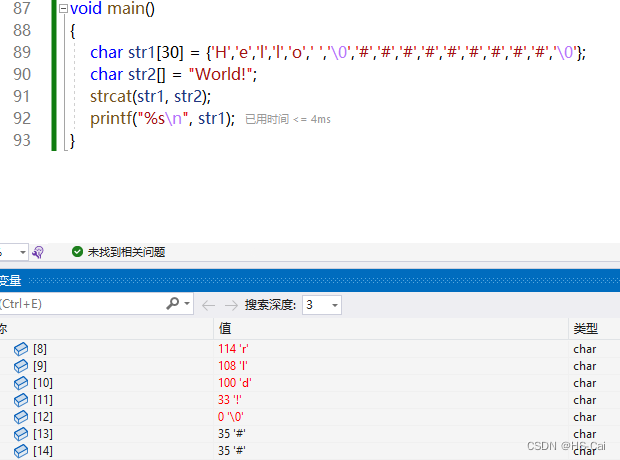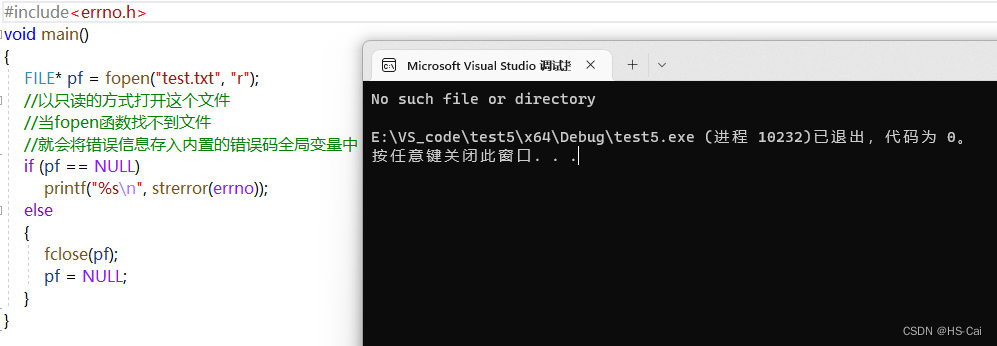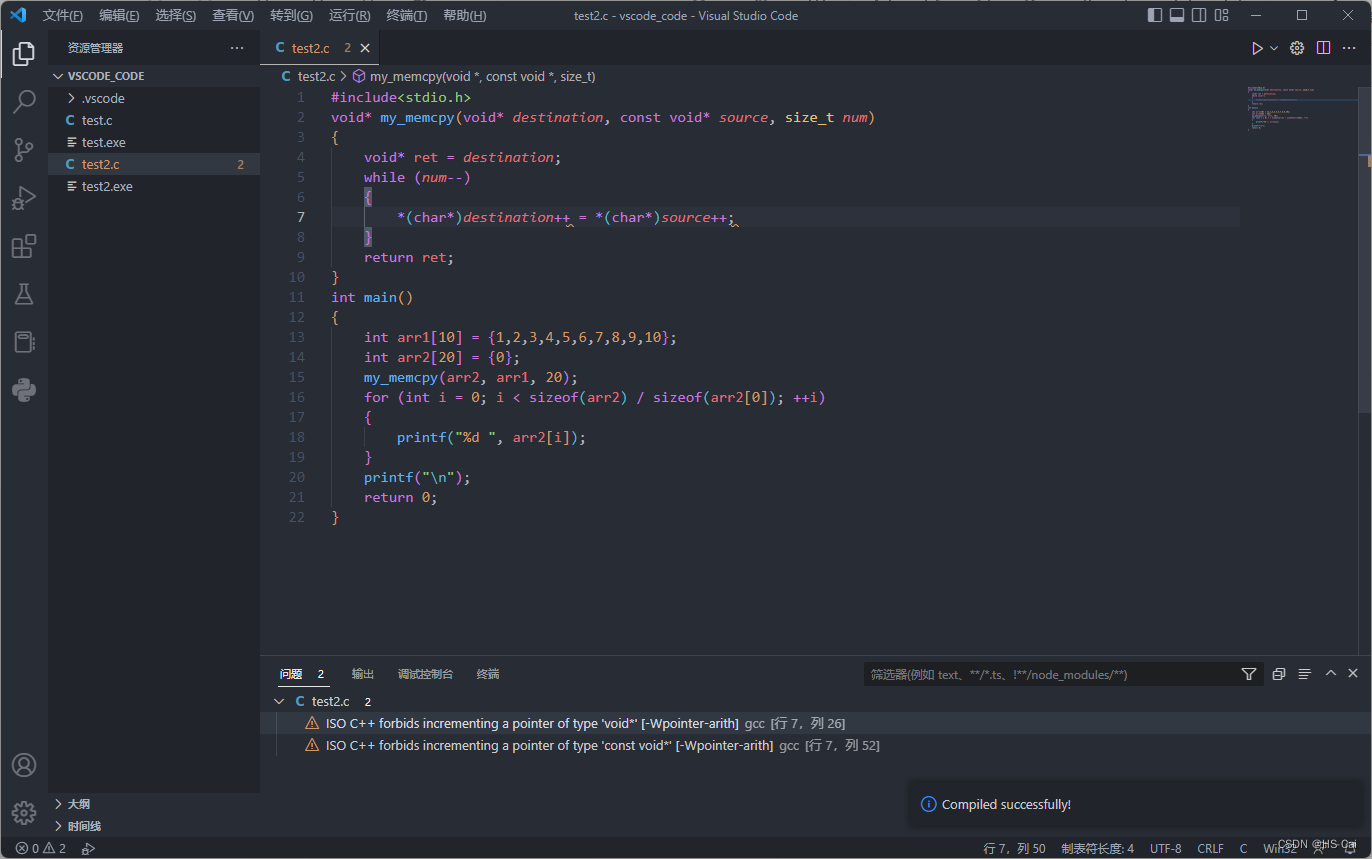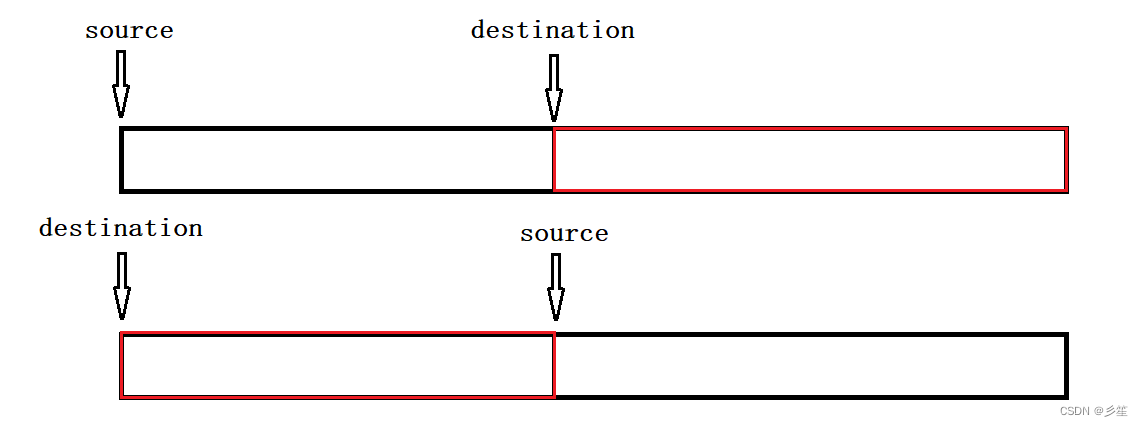-
求字符串长度
- strlen
-
长度不受限制的字符串函数
- strcpy
- strcat[重要][模拟实现]
- strcmp[重要][模拟实现]
- 长度受限制的字符串函数
- strncpy
- strncat
- strncmp
- 字符串查找
- strstr[重要][模拟实现]
- strtok[陌生]
- 错误信息报告
- strerror[陌生]
- perror[陌生]
- 字符操作
- 内存操作函数
- memcpy
- memmove[重要][模拟实现]
- memset
- memcmp
字符函数和字符串函数
求字符串长度
strlen
size_t strlen ( const char * str );
- 字符串已经以'\0'作为结束标志,strlen函数返回的是在字符串中'\0'前面出现的字符个数(不包含'\0' )。
- 参数指向的字符串必须要以'\0'结束。
- 函数的返回值为size_t,是无符号的(易错)。
模拟实现
#include<stdio.h>
#include<assert.h>
size_t my_strlen(const char* str)
{
assert(str != NULL);
int count = 0;
while (*str)
{
++count;
++str;
}
return count;
}
void main()
{
char str[] = "Hello World!";
printf("%zd", my_strlen(str));
}长度不受限制的字符串函数
strcpy
char * strcpy ( char * destination, const char * source );
- Copies the C string pointed by source into the array pointed by destination, including the terminating null character(and stopping at that point).
- 源字符串必须以'\0'结束。
- 会将源字符串中的'\0'拷贝到目标空间。
- 目标空间必须足够大,以确保能存放源字符串。
- 目标空间必须可变。
- 返回值为目标地址。
*strcat
char * strcat ( char * destination, const char * source );
-
Appends a copy of the source string to the destination string. The terminating null character in destination is overwritten by the first character of source, and a null character is included at the end of the new string formed by the concatenation of both in destination.
-
检测到源字符串的第一个'\0'就开始追加。[注意]

-
源字符串必须以'\0'结束。
-
目标空间必须有足够的大,能容纳下源字符串的内容。
-
目标空间必须可修改。
-
字符串无法自己给自己追加。
-
返回值为目标地址。
模拟实现
#include<stdio.h>
#include<assert.h>
char* my_strcat(char* destination, const char* source)
{
assert(destination && source);
char* ret = destination;
while (*destination)
++destination;
while (*destination++ = *source++);
//利用符号优先级,++高于=
return ret;
//返回初始的目的地址
}
void main()
{
char str1[20] = "Hello ";
char str2[] = "World!";
printf("%s\n", my_strcat(str1, str2));
}strcmp
int strcmp ( const char * str1, const char * str2 );
- This function starts comparing the first character of each string. If they are equal to each other, it continues with the following pairs until the characters differ or until a terminating null-character is reached.
- 标准规定∶
- 第一个字符串大于第二个字符串,则返回大于0的数字。
- 第一个字符串等于第二个字符串,则返回0。
- 第一个字符串小于第二个字符串,则返回小于0的数字。
模拟实现
int my_strcmp(const char* str1, const char* str2)
{
int ret = 0;
while ((ret = *(unsigned char*)str1 - *(unsigned char*)str2) == 0 && *str2)
{
str1++;
str2++;
}
return ((-ret) < 0) - (ret < 0);
}
void main()
{
printf("%d", my_strcmp("abcdef", "abcdh"));
}长度受限制的字符串函数
strncpy
char * strncpy ( char * destination, const char * source, size_t num );
- 若num超过源字符串的长度,则剩下的部分会以'\0'来进行替换。
strncat
char * strncat ( char * destination, const char * source, size_t num );
- 若num超过源字符串的长度,函数识别到源字符串末尾'\0'之后直接停止。
- 若num小于源字符串的长度,函数会在末尾添上'\0'而后停止。
strncmp
int strncmp ( const char * str1, const char * str2, size_t num );
- n来指示所需要比较的位数。
字符串查找
*strstr[重要]
char * strstr ( const char * str1, const char * str2);
- Returns a pointer to the first occurrence of str2 in str1, or a null pointer if str2 is not part of str1.
*模拟实现[重要]
#define _CRT_SECURE_NO_WARNINGS 1
#include<stdio.h>
char* my_strstr(const char* str1, const char* str2)
{
const char* s1 = NULL;
const char* s2 = NULL;
char* cp = (char*)str1;
if (!*str2)
return (char*)str1;
while (*cp)
{
s1 = cp;
s2 = str2;
while (*s1 && *s2 &&(*s1 == *s2))
s1++,s2++;
if (!*s2)
return cp;
cp++;
}
return NULL;
}
void main()
{
char str1[] = "abcdefghijk";
char str2[] = "ijk";
char* ret = my_strstr(str1, str2);
if (ret == NULL)
printf("未找到!\n");
else
printf("找到了!\n%s\n", ret);
}strtok[限制酶]
char * strtok ( char * str, const char * sep );
- sep参数是个字符串,定义了用作分隔符的字符集合。
- 第一个参数指定一个字符串,它包含了0个或者多个由sep字符串中一个或者多个分隔符分割的标记。
- strtok函数找到str中的下一个标记,并将其用\0结尾,返回一个指向这个标记的指针。(注:strtok函数会改变被操作的字符串,所以在使用strtok函数切分的字符串一般都是临时拷贝的内容并且可修改。
- strtok函数的第一个参数不为NULL,函数将找到str中第一个标记,strtok函数将保存它在字符串中的位置。
- strtok函数的第一个参数为NULL,函数将在同一个字符串中被保存的位置开始,查找下一个标记
- 如果字符串中不存在更多的标记,则返回NULL指针。
使用方式

错误信息报告
strerror[把错误码转为错误信息]
char * strerror ( int errnum );

配合c语言自带的全局变量错误码使用可以报出当前的错误信息
变量引用的头文件-------errno.h
变量名称-------------------errno

perror[直接输出错误信息]
void perror ( const char * str );
perror("接入自定义信息");
头文件:stdio.h

字符操作
头文件:#include<ctype.h>
字符分类函数
int 函数名 ( int c );
如果是满足条件返回非0值,不满足条件返回0。
| 函数 | 如果它的参数符合下列条件就返回真 |
| iscntrl | 任何控制字符 |
| isspace | 空白字符:空格' ' 换页'\f' 换行'\n' 回车'\r' 制表符'\t'或者垂直制表符'\v' |
| isdigit | 十进制数字 0~9 |
| isxdigit | 十六进制数字,包括所有十进制数字,小写字母a~f,大写字母A~F |
| islower | 小写字母a~z |
| isupper | 大写字母A~Z |
| isalpha | 字母a~z或A~Z |
| isalnum | 字母或者数字,a~z,A~Z,0~9 |
| ispunct | 标点符号,任何不属于数字或者字母的图形字符(可打印) |
| isgraph | 任何图形字符 |
| isprint | 任何可打印字符,包括图形字符和空白字符 |

字符转换函数
- tolower(转小写)
- toupper(转大写)
int tolower ( int c );
int toupper ( int c );
使用情况
内存操作函数
头文件#include <string.h>或#include<memory.h>
内存拷贝函数
*拷贝的三种类型--决定从左往右拷贝还是从右往左拷贝
1.source与destination所指向的内存完全不重叠
2.有重叠区域,并且destination小于source
3.有重叠区域,并且source大于destination
左往右拷贝还是从右往左拷贝取决于调整后红框在前
*memcpy
void * memcpy ( void * destination, const void * source, size_t num );
以字节为单位拷贝
返回destination的指针
(memcpy函数应该拷贝不重叠的内存 拷贝重叠内存可能出现问题)
(vs中既可以拷贝不重叠,也可以拷贝重叠内存,尽量以标准实现)
模拟实现
#include<stdio.h>
void* my_memcpy(void* destination, const void* source, size_t num)
{
void* ret = destination;
while (num--)
{
*(char*)destination = *(char*)source;
destination = (char* )destination +1;
source = (char* )source +1;
//标准的写法,使用++会在部分编译器内报错
}
return ret;
}
void main()
{
int arr1[10] = {1,2,3,4,5,6,7,8,9,10};
int arr2[20] = {0};
my_memcpy(arr2, arr1, 20);
for (int i = 0; i < sizeof(arr2) / sizeof(arr2[0]); ++i)
{
printf("%d ", arr2[i]);
}
printf("\n");
}注:(char*)为暂时性的强制类型转换与*和++配合使用容易出错,不同编译器下括号使用不同,采用+1来进行更为标准。
vscode

vs2022

*memmove
void * memcpy ( void * destination, const void * source, size_t num );
以字节为单位拷贝
返回destination的指针
(memmove函数可以拷贝不重叠的内存)(与memcpy功能类似)
模拟实现
#define _CRT_SECURE_NO_WARNINGS 1
#include<stdio.h>
#include<string.h>
void* my_memmove(void* dest, void* src, size_t num)
{
if (dest > src)
for (int i = num - 1; i >= 0; --i)
((char*)dest)[i] = ((char*)src)[i];
else
for (int i = 0; i < num; ++i)
((char*)dest)[i] = ((char*)src)[i];
return dest;
}
void main()
{
int arr1[] = { 1,2,3,4,5,6,7,8,9,10 };
//my_memmove(arr1 + 2, arr1, 20);
my_memmove(arr1, arr1 + 2, 20);
for (int i = 0; i < sizeof(arr1) / sizeof(arr1[0]); ++i)
{
printf("%d ", arr1[i]);
}
printf("\n");
}memset
void * memset ( void * ptr, int value, size_t num );
- 以字节为单位设置内存。
- value该值以int类型传递,但该函数使用此值的无符号char类型转换填充内存块。
使用情况

内存比较函数
memcmp
int memcmp ( const void * ptr1, const void * ptr2, size_t num );
<0 | 两个内存块中不匹配的第一个字节在 ptr1 中的值低于 ptr2 中的值(如果计算以无符号字符值) |
0 | 两个内存块的内容相等 |
>0 | 两个内存块中不匹配的第一个字节在 ptr2 中的值大于在 ptr2 中的值(如果计算以无符号字符值) |
使用情况



























 652
652











 被折叠的 条评论
为什么被折叠?
被折叠的 条评论
为什么被折叠?








